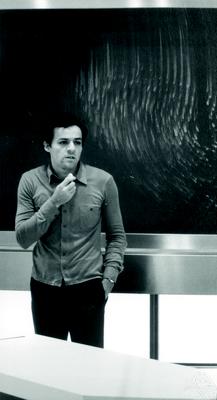Related Research Articles

Kenneth Geddes "Ken" Wilson was an American theoretical physicist and a pioneer in leveraging computers for studying particle physics. He was awarded the 1982 Nobel Prize in Physics for his work on phase transitions—illuminating the subtle essence of phenomena like melting ice and emerging magnetism. It was embodied in his fundamental work on the renormalization group.

The International Union of Pure and Applied Physics is an international non-governmental organization whose mission is to assist in the worldwide development of physics, to foster international cooperation in physics, and to help in the application of physics toward solving problems of concern to humanity. It was established in 1922 and the first General Assembly was held in 1923 in Paris. The Union is domiciled in Geneva, Switzerland.
Reviews of Modern Physics is a quarterly peer-reviewed scientific journal published by the American Physical Society. It was established in 1929 and the current editor-in-chief is Michael Thoennessen. The journal publishes review articles, usually by established researchers, on all aspects of physics and related fields. The reviews are usually accessible to non-specialists and serve as introductory material to graduate students, which survey recent work, discuss key problems to be solved and provide perspectives toward the end.
STATPHYS or IUPAP International Conference on Statistical Physics is a series of conferences organized by the International Union of Pure and Applied Physics. The conferences take place every three years in a different continent to give the maximum international relevance and visibility to the event. It is the world event for the broad field of statistical physics and all its interdisciplinary developments. The first meeting was in Florence (Italy) from 17 to 20 May 1949. After a pioneering period the periodicity of three years was established and the conference has acquired more and more importance. The participation has reached peaks up to 1500 participants in the recent years. Also on the occasion of this conference the prestigious Boltzmann medal is awarded. In addition several satellite meetings are usually held along with the main event, adding to the scientific value of the meeting.

Giovanni Gallavotti is an Italian mathematical physicist, born in Naples on 29 December 1941.

Daan Frenkel is a Dutch computational physicist in the Department of Chemistry at the University of Cambridge.
The Ellis R. Lippincott Award is awarded annually to recognize "an individual who has made significant contributions to vibrational spectroscopy as judged by his or her influence on other scientists." It was jointly established in 1975 by The Optical Society, The Coblentz Society, and The Society for Applied Spectroscopy. The award honors Ellis R. Lippincott, a vibrational spectroscopist who worked at the University of Maryland. Lippincott was one of the developers of the Diamond anvil cell, which is used in high pressure research.
Kyozi Kawasaki was a Japanese physicist. His research interests include chemical physics and statistical mechanics. In 2001, Kawasaki was awarded the Boltzmann Medal for "his contribution to our understanding of dynamic phenomena in condensed matter systems, in particular the mode-coupling theory of fluids near criticality, and nonlinear problems, such as critical phenomena in sheared fluids and phase separations".
The Charles Hard Townes Award of Optica is a prize for quantum electronics, including laser physics. Awarded annually since 1981, it is named after the Nobel Prize-winning laser pioneer Charles H. Townes.

John Francis Brady is an American chemical engineer and the Chevron Professor of Chemical Engineering and Mechanical Engineering at the California Institute of Technology. He is a fluid mechanician and creator of the Stokesian dynamics method for simulating suspensions of spheres and ellipsoids in low Reynolds number flows. He is an elected fellow of the American Physical Society, a fellow of the Society of Rheology, as well as a member of the National Academy of Sciences, the National Academy of Engineering, and the American Academy of Arts and Sciences.
The Simon Memorial Prize is an award that honors 'distinguished work in experimental or theoretical low temperature physics'. The prize is awarded by the Institute of Physics and is presented at the International Conference on Low Temperature Physics, which takes place every three years. The prize is named after Francis Simon, who contributed eminently to the field of low-temperature physics. The first prize was awarded in 1959 to Heinz London.
An active fluid is a densely packed soft material whose constituent elements can self-propel. Examples include dense suspensions of bacteria, microtubule networks or artificial swimmers. These materials come under the broad category of active matter and differ significantly in properties when compared to passive fluids, which can be described using Navier-Stokes equation. Even though systems describable as active fluids have been observed and investigated in different contexts for a long time, scientific interest in properties directly related to the activity has emerged only in the past two decades. These materials have been shown to exhibit a variety of different phases ranging from well ordered patterns to chaotic states. Recent experimental investigations have suggested that the various dynamical phases exhibited by active fluids may have important technological applications.
The William F. Meggers Award has been awarded annually since 1970 by the Optical Society for outstanding contributions to spectroscopy. It was established to honor William Frederick Meggers and his contributions to the fields of spectroscopy and metrology.
The Frederic Ives Medal is the highest award of the Optical Society, recognizing overall distinction in optics. The prize was established in 1928 by Herbert E. Ives in honor of his father, Frederic Ives. Initially awarded every two years, it has been awarded annually since 1951. The prize is funded by the Jarus W. Quinn Ives Medal Endowment.
Yves Pomeau, born in 1942, is a French mathematician and physicist, emeritus research director at the CNRS and corresponding member of the French Academy of sciences. He was one of the founders of the Laboratoire de Physique Statistique, École Normale Supérieure, Paris. He is the son of literature professor René Pomeau.

Lectures on Theoretical Physics is a six-volume series of physics textbooks translated from Arnold Sommerfeld's classic German texts Vorlesungen über Theoretische Physik. The series includes the volumes Mechanics, Mechanics of Deformable Bodies, Electrodynamics, Optics, Thermodynamics and Statistical Mechanics, and Partial Differential Equations in Physics. Focusing on one subject each semester, the lectures formed a three-year cycle of courses that Sommerfeld repeatedly taught at the University of Munich for over thirty years. Sommerfeld's lectures were famous and he was held to be one of the greatest physics lecturers of his time.
Introduction to Quantum Mechanics, often called Griffiths, is an introductory textbook on quantum mechanics by David J. Griffiths. The book is considered a standard undergraduate textbook in the subject. Originally published by Pearson Education in 1995 with a second edition in 2005, Cambridge University Press (CUP) reprinted the second edition in 2017. In 2018, CUP released a third edition of the book with Darrell F. Schroeter as co-author; this edition is known as Griffiths and Schroeter.
Helmut Rechenberg was a German physicist and science historian.
The Paul Dirac Medal and Prize is a gold medal awarded annually by the Institute of Physics for "outstanding contributions to theoretical physics". The award, which includes a £1000 prize, was decided upon by the Institute of Physics in 1985, and first granted in 1987.
References
- ↑ Hao, Bailin (1996-03-18). "The Boltzmann medal". Statphys 19 - Proceedings of the 19th IUPAP International Conference on Statistical Physics. World Scientific. pp. xix–xxii. ISBN 978-981-4549-08-0.
- ↑ Nadis, Steve (2000). "Computer glitch unleashes prize nomination debate". Nature. 404 (6776): 320. doi: 10.1038/35006221 . ISSN 0028-0836. S2CID 36669807.
- 1 2 Ruskin, H.; Cherry, R. (1977-12-14). "IUPAP Conference on Statistical Physics (13th)": 2.
{{cite journal}}: Cite journal requires|journal=(help) - ↑ Pearce, Paul A (2016-10-14). "Hard hexagons, hard squares and hard mathematics". Journal of Physics A: Mathematical and Theoretical. 49 (41): 411003. Bibcode:2016JPhA...49O1003P. doi:10.1088/1751-8113/49/41/411003. ISSN 1751-8113. S2CID 125201916.
- ↑ "Preface [Journal of Statistical Physics volume 102, pages 373–374 (2001)]". Journal of Statistical Physics. 102 (3/4): 373–374. 2001. doi:10.1023/A:1017317713287.
- ↑ Fisher, Michael E. (1984). "Walks, walls, wetting, and melting". Journal of Statistical Physics. 34 (5–6): 667–729. Bibcode:1984JSP....34..667F. doi:10.1007/BF01009436. ISSN 0022-4715. S2CID 122975700.
- 1 2 Khanin, Konstantin (2017). "Mathematical Journey of Yakov Sinai". Journal of Statistical Physics. 166 (3–4): 463–466. Bibcode:2017JSP...166..463K. doi:10.1007/s10955-016-1668-8. ISSN 0022-4715. S2CID 126102547.
- ↑ Brenner, Michael P. (2016). "Leo Philip Kadanoff". Physics Today. 69 (4): 69–70. Bibcode:2016PhT....69d..69B. doi: 10.1063/PT.3.3146 .
- 1 2 "Lebowitz and Parisi are Boltzmann Medalists". Physics Today. 45 (11): 104. 1992. Bibcode:1992PhT....45k.104.. doi:10.1063/1.2809888. ISSN 0031-9228.
- ↑ Goldenfeld, Nigel (2016-01-05). "Samuel Frederick Edwards: Founder of modern polymer and soft matter theory". Proceedings of the National Academy of Sciences. 113 (1): 10–11. Bibcode:2016PNAS..113...10G. doi: 10.1073/pnas.1523001113 . ISSN 0027-8424. PMC 4711878 . PMID 26699498.
- 1 2 Loring, Roger F.; Koga, Kenichiro; Ben-Amotz, Dor (2018-04-05). "Tribute to Benjamin Widom". The Journal of Physical Chemistry B. 122 (13): 3203–3205. doi:10.1021/acs.jpcb.8b00129. ISSN 1520-6106. PMID 29618212.
- 1 2 "Alder, Kawasaki Named This Year's Boltzmann Medalists". Physics Today. 54 (6): 73. 2001. Bibcode:2001PhT....54S..73.. doi: 10.1063/1.1387602 . ISSN 0031-9228.
- 1 2 "Cohen, Stanley Win Boltzmann Medals". Physics Today. 57 (7): 73. 2004. doi:10.1063/1.2408583. ISSN 0031-9228.
- ↑ Tsallis, Constantino (2020-10-15). "Retirement of Prof. H. Eugene Stanley as Main Editor of Physica A/Elsevier". Physica A: Statistical Mechanics and Its Applications. 556: 124834. Bibcode:2020PhyA..55624834T. doi:10.1016/j.physa.2020.124834. S2CID 225697874.
{{cite journal}}: CS1 maint: date and year (link) - ↑ Mareschal, Michel (2019-07-09). "From Varenna (1970) to Como (1995): Kurt Binder's long walk in the land of criticality". The European Physical Journal H. 44 (2): 161–179. Bibcode:2019EPJH...44..161M. doi:10.1140/epjh/e2019-100016-3. ISSN 2102-6459. S2CID 198440745.
{{cite journal}}: CS1 maint: date and year (link) - ↑ "Statphys 23 - Boltzmann Medal". www.statphys23.org. Retrieved 2022-06-23.
- ↑ Cardy, John (2010-10-07). "The ubiquitous ' c ': from the Stefan–Boltzmann law to quantum information". Journal of Statistical Mechanics: Theory and Experiment. 2010 (10): P10004. arXiv: 1008.2331 . Bibcode:2010JSMTE..10..004C. doi:10.1088/1742-5468/2010/10/P10004. ISSN 1742-5468. S2CID 119105135.
- ↑ statphys.sissa. "Boltzmann medal | Statistical Physics @ Trieste" . Retrieved 2022-06-23.
- 1 2 "STATPHYS25". www.statphys25.org. Retrieved 2022-06-23.
- ↑ Frenkel, Daan; Louët, Sabine (2016-06-28). "Interview with Daan Frenkel, Boltzmann Medallist 2016: Simulating soft matter through the lens of statistical mechanics". The European Physical Journal E. 39 (6): 68. doi:10.1140/epje/i2016-16068-7. ISSN 1292-8941. PMID 27349557. S2CID 45142053.
{{cite journal}}: CS1 maint: date and year (link) - ↑ Pomeau, Yves; Louët, Sabine (2016-06-28). "Interview with Yves Pomeau, Boltzmann Medallist 2016: The universality of statistical physics interpretation is ever more obvious". The European Physical Journal E. 39 (6): 67. doi:10.1140/epje/i2016-16067-8. ISSN 1292-8941. PMID 27349556. S2CID 25538225.
{{cite journal}}: CS1 maint: date and year (link) - ↑ "Boltzmann Medal for Herbert Spohn". TUM (in German). Retrieved 2022-06-23.
- 1 2 Desikan, Shubashree (2022-03-05). "Deepak Dhar and John J. Hopfield chosen for the Boltzmann medal". The Hindu. ISSN 0971-751X . Retrieved 2022-06-23.